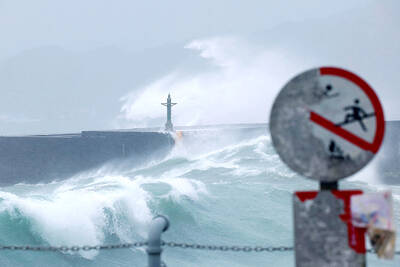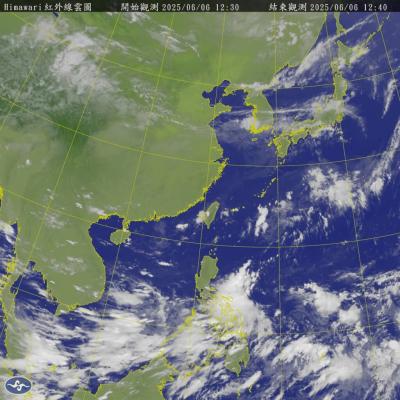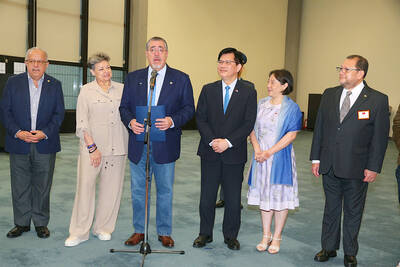The coining of a new phrase, "two sides of the Taiwan Strait, One China," to describe an old debate begs the question of whether the already term-laden cross-strait relations might truly benefit from this latest addition.
Coined in a communique forged by Chinese President Hu Jintao (胡錦濤) and People First Part (PFP) leader James Soong (宋楚瑜) on Thursday, the new phrase was added in parenthese after a reference to the so-called "1992 consensus."
But while the PFP billed the communique as a constructive redefinition of the "1992 consensus," it is not immediately clear what new ideas the term brings to the discussion.
While further explanation can be expected in the coming weeks, remarks by PFP representatives so far seem to suggest that despite the novel terminology, the "two sides of the Taiwan Strait, One China" notion does not stray ideologically far from its previous stance on the "1992 consensus."
In other words, both sides of the Taiwan Strait will adhere to the "one China" principle, but each is entitled to interpret "one China" as it sees fit.
The "1992 consensus" originates from verbal descriptions of the political situation between Taiwan and China following a meeting in Hong Kong in 1992 between negotiators from the semi-official Straits Exchange Foundation (SEF) and its Chinese counterpart, the Association for Relations Across the Taiwan Strait (ARATS). The exchange was retroactively dubbed the "1992 consensus" by former Mainland Affairs Council Chairman Su Chi (
While the communique is essentially Hu's nod of approval to the "two sides of the Taiwan Strait, One China" description of cross-strait ties, it remains to be seen what Beijing's interpretation of this term might be and whether any substantial agreement was reached between Soong and Hu.
It is appropriate to note, however, that just before heading in to the closed-door meeting during which the communique was inked, Hu remarked that "adherence to the `one China' principle embodying `1992 consensus' and opposition to Taiwanese independence are the political foundations for negotiations."
President Chen Shui-bian (
"What has changed in Beijing's stance? It looks like nothing has changed," Chen said during an interview Thursday, indicating that the "1992 consensus" was tantamount to the "one China" principle to Beijing.
The deadlock thus seems unaltered, but for the addition of new semantic input on describing what happened in 1992. Alexander Huang (
"Actually, the Chinese Communist Party [CCP] just reiterated long-held positions and interpretations of what happened in 1992," Huang said.
"The difference [marked by this] meeting is that both sides decided to reiterate in black and white, state again, and put it into a communique between the two parties. If there's anything new, it's that they put it in the communique to remind people that we have some kind of tacit agreement to disagree," Huang said.
The first point of the communique puts to paper the views which had been verbally expressed in 1992. It states that the SEF put forth at the time that "in the process of realizing national unification by joint efforts across the Strait, both sides are entitled to interpret the meaning of `one China' as they see fit, even though both sides insist on the `one China' principle."
Likewise, it reiterates the ARATS' expressed stance at the time that "both sides of the Taiwan Strait insist on the `one China' principle and strive for national unification, however, the meaning of `one China' shall not be involved in cross-Strait talks of a functional nature."
But, the documentation of past differences might serve only to give new life to old disagreements. If authorities in Taiwan and Beijing do not see eye to eye on the "1992 consensus" to begin with, can "two sides of the Taiwan Strait, one China" offer any new options for the resolution of differences? How constructive is a term that is a mutual recognition of a consensus that is in essence a recognition of political differences?
"The problem in the past 10 or so years was whether you could allow two interpretations of `one China.' And today, the problem is whether you allow two terminologies for the `1992 consensus,'" Huang said.
While the term "1992 consensus" had been fabricated to amplify the degree of agreement reached then and play down elements of disagreement, it is questionable whether a re-working of the consensus into that of "two sides of the Strait, one China" is not just a rehashing of old ideas and the reopening of an old can of worms.
"This might seem a step in the wrong direction for the pan-green political camps," Tamkang University's Institute of China Studies professor Chang Wu-Ueh (張五岳) said on Thursday, indicating that the independence-leaning pan-green camp might have been more willing to work with the "1992 consensus," than Soong's latest revision.
Huang also agreed that the "1992 consensus" might have been a "better sell" in Taiwan than the option spelled out by Soong.
"If I were in power, I would just stick with the 92 thing," Huang said, explaining that references to "one China" would be harder for the Taiwanese audience to stomach.
But while buffering long standing differences of "one China" with another layer of terminology in search of a resolution might seem like wringing a dry towel for water, it remains to be seen whether and how the administration might turn the situation into an opportunity for the future of cross-strait ties.

Greenpeace yesterday said that it is to appeal a decision last month by the Taipei High Administrative Court to dismiss its 2021 lawsuit against the Ministry of Economic Affairs over “loose” regulations governing major corporate electricity consumers. The climate-related lawsuit — the first of its kind in Taiwan — sought to require the government to enforce higher green energy thresholds on major corporations to reduce emissions in light of climate change and an uptick in extreme weather. The suit, filed by Greenpeace East Asia, the Environmental Jurists Association and four individual plaintiffs, was dismissed on May 8 following four years of litigation. The

STAY AWAY: An official said people should avoid disturbing snakes, as most do not actively attack humans, but would react defensively if threatened Taitung County authorities yesterday urged the public to stay vigilant and avoid disturbing snakes in the wild, following five reported snakebite cases in the county so far this year. Taitung County Fire Department secretary Lin Chien-cheng (林建誠) said two of the cases were in Donghe Township (東河) and involved the Taiwan habus, one person was bit by a Chinese pit viper near the South Link Railway and the remaining two were caused by unidentified snakes. He advised residents near fields to be cautious of snakes hiding in shady indoor areas, especially when entering or leaving their homes at night. In case of a

A tropical disturbance off the southeastern coast of the Philippines might become the first typhoon of the western Pacific typhoon season, the Central Weather Administration (CWA) said. The system lacks a visible center and how it would develop is only likely to become clear on Sunday or Monday, the CWA said, adding that it was not yet possible to forecast the potential typhoon's effect on Taiwan. The American Meteorological Society defines a tropical disturbance as a system made up of showers and thunderstorms that lasts for at least 24 hours and does not have closed wind circulation.

DIPLOMACY: It is Guatemalan President Bernardo Arevalo’s first visit to Taiwan since he took office last year, while Eswatini’s foreign minister is also paying a visit A delegation led by Guatemalan President Bernardo Arevalo arrived in Taiwan yesterday afternoon and is to visit President William Lai (賴清德) today. The delegation arrived at Taiwan Taoyuan International Airport at 4:55pm, and was greeted by Minister of Foreign Affairs Lin Chia-lung (林佳龍). It is Arevalo’s first trip to Taiwan since he took office last year, and following the visit, he is to travel to Japan to celebrate the 90th anniversary of diplomatic relations between the two countries. Arevalo said at the airport that he is very glad to make the visit to Taiwan, adding that he brings an important message of responsibility